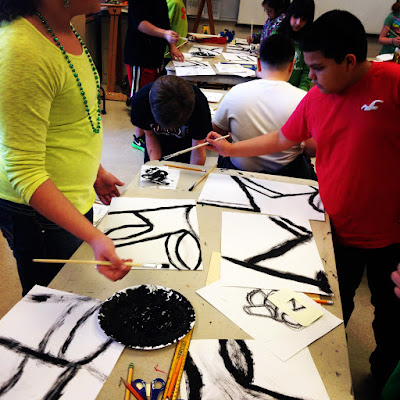About a month ago, I came across a Pinterest post (I think) of the DC Sketchers, with the related image of a group of people, gathered around a small table,
sketching a still life of styrofoam cups.
I thought, "Oh how fun"!
I then proceeded to think about my students perceptions of common objects and their inherent nature to "know things", just by having some sort of experience with them. Take the simple styrofoam cup for example. This simple vessel is used everyday, from the coffee cups at school functions to quenching the thirst of miniature soccer players, to 'pots' that will soon grow beans in our classrooms.
They are everywhere and by being everywhere, these familiar objects become common and common leads to inattentiveness.
And then I thought, again, "Oh this WILL be fun"!
In preparation for this art unit, I reflected on the numerous art installations I found on Pinterest and Scholastic Art Magazine, created by this very simple object. With a little 'Googling', I came across Styrogami. Yes, it's an actual thing and it is AMAZING (Check it out Here)
But my focus was not just to make a really cool sculpture, my focus was to encourage my students to pay attention to details and 'see' how a simple curve can transform something flat into something with volume. I wanted my students to analyze materials and evaluate their effectiveness when using them. I wanted my students to see how even simple shapes can be transformed into something bigger and magical.
I wanted my students to see how something ordinary can become extraordinary, and how something seemingly simple is, in reality, complex.
Throughout this school year, I have been focusing on creating art units that 'test' my students' skills but also demonstrate their growth to them, fostering an understanding for process over product. After all, how much can we possibly do with a styrofoam cup?
My overall focus was for students to understand the 'process' of making art, is as important, if not more important than the product. To illustrate this idea, I referred to the artist Richard Serra.
My overall focus was for students to understand the 'process' of making art, is as important, if not more important than the product. To illustrate this idea, I referred to the artist Richard Serra.
My speculations were pretty accurate. To begin the unit, I simply passed out some manilla paper, asked the students to fold it in half, write their name and "Perceptions of Space" on the cover and then draw a styrofoam cup.
With cups already on the table, my confident students took the challenge with full force and began to vigorously draw a styrofoam cup. I heard, "This is easy" and "I'm done" very often, all the while taking note that the majority of these, very confident, students were not even looking at the cups.





After stopping them, we took a little gallery walk around the room and evaluated our peers' efforts. There were a lot of groans.....
My first question was "Does it look like a styrofoam cup?"
The majority offered their responses with a "eeehh...."
Then I asked, "Did you look at the cup?"
The majority offered a "eeeehhhh..."
Then I asked, "Why not?"
"Because it's just a styrofoam cup".
Let's try this again.
The entire instructional sequence spanned 8 weeks (probably more) but you never would have thought it, with all the interest and sheer will to master drawing a cup. We started with simple line drawings and progressed to larger abstract paintings...to styrofoam cup sculptures...to photography...and back to a simple cup.
All the while building our observational drawings skills, visualization skills, problem solving skills and reflective skills.
Pretty amazing stuff.
 Check out the rest of the snapshots
Check out the rest of the snapshots
and the entire Art Unit with "I Can" statements, rubric and discussion sequence!
Follow on our Instagram page:
sanborn_smockroom
xoxo, Smock Room
The entire instructional sequence spanned 8 weeks (probably more) but you never would have thought it, with all the interest and sheer will to master drawing a cup. We started with simple line drawings and progressed to larger abstract paintings...to styrofoam cup sculptures...to photography...and back to a simple cup.
All the while building our observational drawings skills, visualization skills, problem solving skills and reflective skills.
Pretty amazing stuff.
 Check out the rest of the snapshots
Check out the rest of the snapshotsand the entire Art Unit with "I Can" statements, rubric and discussion sequence!
Follow on our Instagram page:
sanborn_smockroom
xoxo, Smock Room






No comments:
Post a Comment